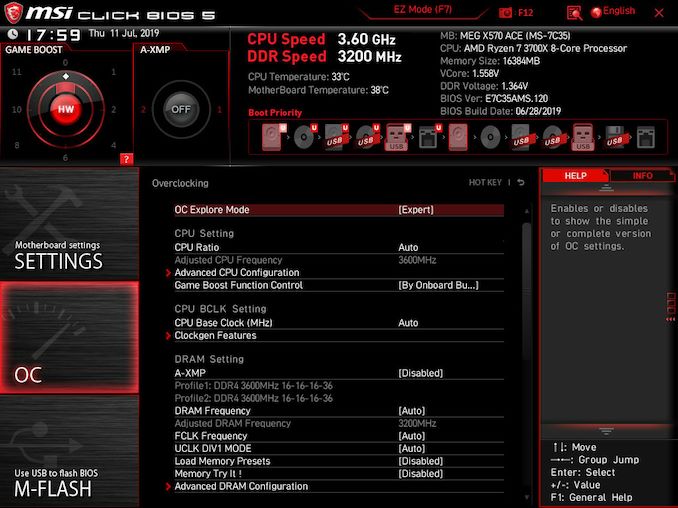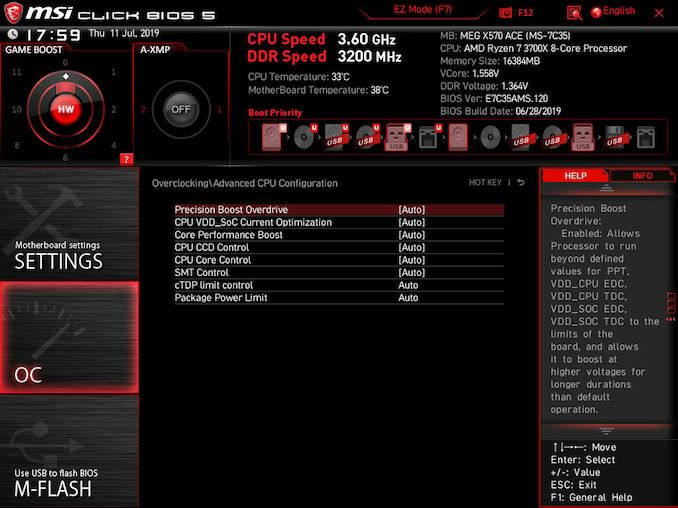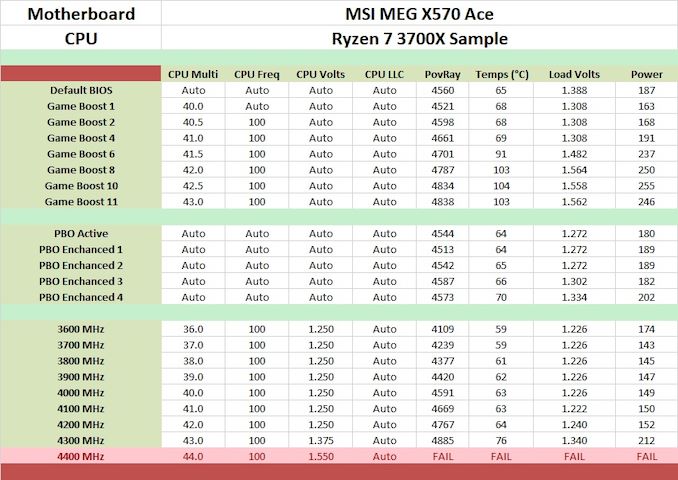The MSI MEG X570 Ace Motherboard Review: Ace in the Hole at $369
by Gavin Bonshor on July 18, 2019 11:00 AM EST- Posted in
- Motherboards
- AMD
- MSI
- AM4
- Zen 2
- Ryzen 3000
- X570
- MEG
- X570 Ace
- 3700X
- Ryzen 3700X
Overclocking Ryzen 3000
Experience with the MSI MEG X570 Ace
It's no secret that the general consensus of overclocking with the Ryzen 3000 series has been so far disappointing. Whether it be the limitations of the new 7 nm silicon or the insane temperatures that these processors run at when overclocked, or even at stock settings with the stock cooler, to unlock the full potential of these chips, better cooling methods such as premium AIOs and custom water cooling is needed.
Overclocking with the MSI MEG X570 Ace motherboard, there are three ways this can be achieved; within the firmware, with the simple, albeit effective tools inside the MSI Dragon Center application or with the comprehensive AMD Ryzen Master overclocking software. For the purpose of this review, we used the MSI Click BIOS 5 firmware which is very intuitive to use, and although this model was quite laggy, it still worked without issues. While the most commonly changed settings to overclock the processor include the CPU ratio which increases the frequency in increments of 100 MHz and the CPU VCore which increases the voltage pumped into the processor which not only generates extra heat but also increases power consumption.
In addition to the boost feature of the Ryzen 3000 processors, another AMD specific feature is called Precision Boost Overdrive or PBO. The three main variables that PBO works from including package power tracking (PPT), thermal design current (TDC), and the electrical design current (EDC). All three of these can be set within the firmware under the advanced section of the Precision Boost Overdrive menu, although MSI has included four different PBO profiles for users to select from. In addition to these are seven different Game Boost CPU overclocking profiles with each profile ranging from 4.0 GHz all cores up to 4.3 GHz all cores; these go up in increments of 50 MHz.
Overclocking Methodology
Our standard overclocking methodology is as follows. We select the automatic overclock options and test for stability with POV-Ray and OCCT to simulate high-end workloads. These stability tests aim to catch any immediate causes for memory or CPU errors.
For manual overclocks, based on the information gathered from the previous testing, starts off at a nominal voltage and CPU multiplier, and the multiplier is increased until the stability tests are failed. The CPU voltage is increased gradually until the stability tests are passed, and the process repeated until the motherboard reduces the multiplier automatically (due to safety protocol) or the CPU temperature reaches a stupidly high level (105ºC+). Our test bed is not in a case, which should push overclocks higher with fresher (cooler) air.
Overclocking Results
The 12+2 power delivery of the MSI MEG X570 Ace is one of the best we have seen from MSI in recent years and as a result, allowed us to manually overclock our Ryzen 7 3700X sample to 4.3 GHz with a set voltage of 1.375 V. Using the default load line calibration setting, this resulted in a load CPU VCore of 1.340 V which gives us a VDroop of 0.035 V in total. Of course, this can be alleviated by using a more aggressive LLC profile, but for the purposes of our testing, we leave this setting at auto. More voltage pumped into the CPU not only results in higher operating temperatures, but this also increases the overall power consumption.
Testing out each of MSI's seven Game Boost profiles did yield some interesting findings. First of all, each profile overvolted our Ryzen 3700X by a massive margin when you factor in what we achieved by using manual settings. Secondly, the three highest Game Boost profiles pumped insane amounts of CPU VCore in which in turn, made our 240mm AIO closed-loop cooler go into overdrive with temperatures in the triple digits. Outside of extreme overclocking, no Ryzen 3000 processor should be subjected to voltages of 1.562 V for a 4.3 GHz overclock on ambient cooling. Performance however was consistently higher with each of the profiles in our POV-Ray benchmark and by default with the Game Boost profiles, thermal throttling is disabled meaning that there is a trade-off between heat and performance. We also tested with PBO and found that performance was actually worse than the default settings, with MSI's four PBO profiles not really having much of an effect on performance; this leads us to believe for the most part, that PBO on Ryzen 3000 could do with a rework to make it more effective.













92 Comments
View All Comments
Irata - Friday, July 19, 2019 - link
+1I would really like to see the USB performance (also CPU connected USB ports vs. chipset connected ones), the sound quality, network performance.
But overall this is already imho a good review, but it would be better with more tests.
FreihEitner - Thursday, July 18, 2019 - link
It's a crying shame that X470 and X570 only rarely make it to mATX boards. At last count (that I've seen) there are more micronic mITX boards sporting X570 than there are reasonably sized mATX boards sporting X570. I think I've still only ever seen maybe 2 mATX X470 boards as well.Yes my mATX case CAN take an mITX board, but I actually use the second PCIe slot.
Death666Angel - Friday, July 19, 2019 - link
I've only seen one X470 mATX board from AsRack server. But unless you have some interesting PCIe card needs, I doubt 250€ makes much sense for it. :D What was the other one you saw?I'm also a die hard mATX defender, but from what I heard (Buildzoid) it doesn't sell well an manufacturers are not devoting a lot of RnD to it. I think there were a few mATX X570 announced way back when (or leaked) but so far only AsRock has delivered. B550 might come to the rescue, but I wanted a new system now (Haswell is getting long in the tooth), so I just got the MSI Mortar and am happy.
br83taylor - Thursday, July 18, 2019 - link
lack of SATA ports means this motherboard is DOA. What were they thinking....notashill - Thursday, July 18, 2019 - link
They were probably thinking that people who use more than 4 SATA+3 NVMe drives are an incredibly tiny niche not worth catering to with this specific board.FreckledTrout - Thursday, July 18, 2019 - link
I'm pretty sure 3 NVMe drives plus 4 SATA drives satisfies a vast majority of use cases for this type of motherboard.DanNeely - Friday, July 19, 2019 - link
The chipset IO lanes that could have powered 4 more sata ports would end up being shared with either the 3rd m.2 slot or the 3rd PCIe slot and that the cost of support tickets from people who got confused about using feature A disables feature B is higher than profit from the handful of people trying to use a near flagship level consumer motherboard to build a storage server.pavag - Saturday, July 20, 2019 - link
I have a large collection of SATA drives which I want to keep running. Each time I replaced one HDD with SSD, I moved the disk to my desktop, so I care a lot for the quantity of SATA ports.Qasar - Friday, July 19, 2019 - link
um.. is everyone that is complaining about the prices of X570 boards, aware that there could be a B570 chipset still yet to come to target the lower price points of boards ? or has AMD stated that X570 is the only chipset for zen 2 ?haukionkannel - Friday, July 19, 2019 - link
Yes 550 is coming next year!But most b450 boards Are just fine for ryzen3000. Just check out the vrm and you will be fine.